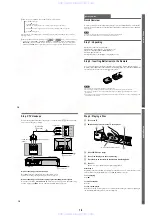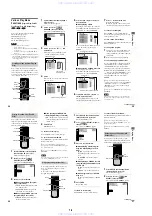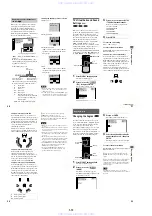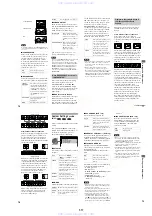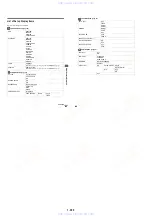
1-17
70
Note
Depending on the DVD,
“
4:3 LETTER BOX
”
maybe
selected automatically instead of
“
4:3 PAN SCAN
”
or
vice versa.
x
SCREEN SAVER
Turns on and off the screen saver so that the
screen saver image appears when you leave
the player in pause or stop mode for 15
minutes, or when you play back a CD for
more than 15 minutes. The screen saver will
help prevent your display device from
becoming damaged (ghosting). Press
H
to
turn off the screen saver.
x
BACKGROUND
Selects the background color or picture on the
TV screen in stop mode or while playing a CD.
x
COMPONENT OUT
This will change the type of signal output
from the COMPONENT VIDEO OUT jacks
on the player. See page 71 for more
information about the different types.
z
When the player outputs a Progressive video
signal, the PROGRESSIVE indicator lights up.
Note
If you select
“
PROGRESSIVE
”
when you connect the
player to a TV that cannot accept the signal in
progressive format (480p), the image quality will
deteriorate. In this case, set the VIDEO OUT SCAN
SELECT switch on the back panel of the player to
INTERLACE. Then set
“
COMPONENT OUT
”
to
“
INTERLACE
”
when you can see the TV screen
correctly, and reset VIDEO OUT SCAN SELECT to
SELECTABLE.
You can fine-tune the Progressive (480p)
video signal output when you select
“
PROGRESSIVE
”
in
“
COMPONENT
OUT
”
of the
“
CUSTOM SETUP
”
display
and connect the player to the TV that is able
to accept the video signal in progressive
format (480p).
x
MODE (Conversion Modes)
DVD software can be divided into two types:
film based software and video based
software. Video based software is derived
from TV, such as dramas and sit-coms, and
displays images at 30 frames/60 fields per
ON
Turns on the screen saver.
OFF
Turns off the screen saver.
JACKET
PICTURE
The jacket picture (still picture)
appears in the background, but
only when the jacket picture is
already recorded on the disc
(CD-EXTRA, etc.). If the disc
does not contain a jacket picture,
the
“
GRAPHICS
”
picture
appears.
GRAPHICS
A preset picture stored in the
player appears in the
background.
BLUE
The background color is blue.
16:9
4:3 LETTER BOX
4:3 PAN SCAN
BLACK
The background color is black.
INTERLACE
This outputs the signal in
interlace format. Select this
when you are connected to a
standard (interlace format)
TV.
PROGRESSIVE
This outputs the signal in
progressive (480p) format.
Select this when you have a
TV that can accept
progressive signals.
When “PROGRESSIVE” is selected in
“COMPONENT OUT”
S
e
tt
ings a
n
d Adjustments
71
second. Film based software is derived from
film and displays images at 24 frames per
second. In order for these images to appear
natural on your screen when output in
PROGRESSIVE mode (60 frames per
second), the progressive video signal needs
to be converted to match the type of DVD
software that you are watching. For more
information about conversion modes, see
“
Progressive Conversion Methods of Film
Based and Video Based Software.
”
Notes
•
Some DVD software contains both Video and Film.
For instance, DVDs of movies may contain the
movie taken on film, and a
“
Making of
”
sequence
taken on video.
•
When you play video based software with
progressive signals, sections of some types of
images may appear unnatural due to the conversion
process when output through the COMPONENT
VIDEO OUT jacks. Images from the S VIDEO OUT
and LINE OUT (VIDEO) 1/2 jacks are unaffected as
they are output in the interlace format.
This player converts video based software
and film based software in the following
manner.
Video based software conversion
Video shows an image by alternately
displaying every other line of an image (field)
at 30 frames (60 fields) per second (Interlace
format).
The Interlace format displays 30 frames (60
fields) per second by displaying every other
line of the image, causing scanning lines to
appear across the image. Furthermore, since
only half of the image is shown at once, the
amount of information contained in an image
is limited.
The Progressive format displays 60 entire
frames per seconds. The player accomplishes
this by converting each field into a frame by
using either a field-based conversion method
or a frame-based conversion method. The
appropriate method is automatically selected
by the player according to the movement of
the images on the screen. If the movement on
the screen is slow, the frame-based
conversion method borrows adjacent field
information to fill in the missing information.
If the movement on the screen is rapid, the
field-based conversion method creates the
missing information by predicting the
movement of the images on the screen from
field to field. The end result is an image that
is higher in quality when compared to the
Interlace format.
AUTO
This will automatically detect if
you are playing Film based or
Video based software and
convert the signal to the
appropriate conversion mode.
Normally select this position.
VIDEO
This will set the conversion
mode for Video based software,
regardless of the type of software
that you are playing.
Progressive Conversion Methods of
Film Based and Video Based
Software
continued
72
Film based software conversion
Film shows an image by displaying an entire
image at 24 frames per second. When you
watch a film on television, the television
displays every other line of the frame as a
field, thus reducing information level and the
clarity of the film image.
This player solves this problem by increasing
the speed at which the frames are displayed,
consecutively showing 3 identical frames
followed by 2 identical frames in the time
that it normally takes to show 2 consecutive
frames. The end result is that the 24 frames
per second are increased to 60 frames per
second, which is the speed at which
Progressive video signals are shown.
This not only allows film to be shown in a
frame based format, it also increases the
clarity and sharpness which is unique to
Progressive format images.
Custom Settings
(CUSTOM
SETUP)
Allows setting up Parental Control and other
settings.
Select
“
CUSTOM SETUP
”
in the Setup
Display. For details on using the display, see
“
Using the Setup Display
”
(page 67).
The default settings are underlined.
x
AUTO PLAY
Select the Auto Play setting when you turn on
the player.
x
DIMMER
Adjusts the lighting of the front panel display.
Converted progressive pictures
Interlace pictures
Converted progressive pictures
OFF
Does not use
“
TIMER,
”
“
DEMO1,
”
or
“
DEMO2
”
to start
playback.
TIMER
Starts playing when the player is
turned on. The player can start
playback at any time when
connected to a timer (not supplied).
Set the timer when the player is in
standby mode (the power indicator
lights up in red).
DEMO1
Starts playing the first
demonstration automatically.
DEMO2
Starts playing the second
demonstration automatically.
BRIGHT
Makes the front panel display bright.
DARK
Makes the front panel display dark.
OFF
Turns off the lighting of the front
panel display.
CUSTOM SETUP
AUTO PLAY:
DIMMER:
PAUSE MODE:
OFF
BRIGHT
AUTO
TRACK SELECTION:
OFF
ON
PARENTAL CONTROL
PLAYBACK MEMORY:
S
e
tt
ings a
nd Adjustments
73
x
PAUSE MODE (DVD only)
Selects the picture in pause mode.
x
PARENTAL CONTROL
t
(DVD only)
Set a password and playback limitation level
for DVDs with playback limitation for
children. For details, see
“
Limiting playback
by children (Parental Control)
”
(page 60).
x
PLAYBACK MEMORY
The player can store the SUBTITLE and
other settings of each disc for up to 50 discs
(Playback Memory).
Set the Playback Memory function ON or
OFF.
The following settings are stored in memory
by the Playback Memory function.
—
AUDIO (page 49)*
—
BNR (page 55)
—
DIGITAL VIDEO ENHANCER (page 58)
—
SUBTITLE (page 54)*
—
SURROUND (page 51)
—
VIDEO EQUALIZER (page 56)
*DVD only
Notes
•
The player can store the settings of up to 50 discs.
When you store the setting of disc number 51, the
first disc setting is canceled.
•
Depending on the DVD, the information stored in
the disc takes priority over the Playback Memory
settings and the function does not work.
•
During playback, do not turn off the player by
pressing POWER on the player. Doing so may
cancel the settings. When you turn off the player,
press
x
first to stop playback and then press
[
/
1
on
the remote. After the power indicator lights up in red
and the player enters standby mode, press POWER
on the player.
x
TRACK SELECTION (DVD only)
Gives the sound track which contains the
highest number of channels priority when
you play a DVD on which multiple audio
formats (PCM, DTS, or Dolby Digital
format) are recorded.
Notes
•
When you set the item to
“
AUTO,
”
the language
may change. The
“
TRACK SELECTION
”
setting
has higher priority than the
“
AUDIO
”
settings in
“
LANGUAGE SETUP
”
(page 68).
•
If you set
“
DTS
”
to
“
OFF
”
(page 75), the DTS sound
track is not played even if you set
“
TRACK
SELECTION
”
to
“
AUTO
”
.
•
If PCM, DTS, and Dolby Digital sound tracks have
the same number of channels, the player selects
PCM, DTS, and Dolby Digital sound tracks in this
order.
•
Depending on the DVD, the audio channel with
priority may be predetermined. In this case, you
cannot give priority to the DTS or Dolby Digital
format by selecting
“
AUTO.
”
AUTO
The picture, including subjects
that move dynamically, is output
with no jitter. Normally select
this position.
FRAME
The picture, including subjects
that do not move dynamically, is
output in high resolution.
ON
Stores the settings in memory
when you eject the disc.
OFF
Does not store the settings in
memory.
OFF
No priority given.
AUTO
Priority given.
www. xiaoyu163. com
QQ 376315150
9
9
2
8
9
4
2
9
8
TEL 13942296513
9
9
2
8
9
4
2
9
8
0
5
1
5
1
3
6
7
3
Q
Q
TEL 13942296513 QQ 376315150 892498299
TEL 13942296513 QQ 376315150 892498299

